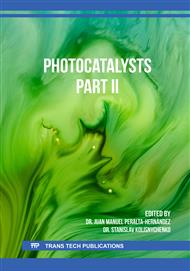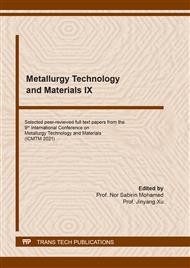[1]
E.P.F. Neto, S. Ullah, V.P. Martinez, J.M.S. Yabarrena and U.P. Rodrigues-Filho, Thermally stable SiO2@TiO2 core@shell nanoparticles for application in photocatalytic self-cleaning ceramic tiles, Materials Advances 2 (2021) 2085-2096.
DOI: 10.1039/d0ma00785d
Google Scholar
[2]
X.H. Tai, S.W Chook, C.W. Lai, K.M. Lee, S. Chong and J.C. Juan, Effective photoreduction of graphene oxide for photodegradation of volatile organic compounds, RSC Advances 9 (2019) 18076-18086.
DOI: 10.1039/c9ra01209e
Google Scholar
[3]
C.C. Pei and W.F. Leung, Solar photocatalytic oxidation of NO by electronspun TiO2/ZnO composite nanofiber mat for enhancing indoor air quality, Journal of Chemical Technology & Biotechnology 89 (2015) 1646-1652.
DOI: 10.1002/jctb.4506
Google Scholar
[4]
R.H. Yuan, F. Huang, J. Jiang, J.F. Huang and C. Su, Monitoring of total volatile organic compound emissions from plastic runway surfaces, Toxicological and Environmental Chemistry 101 (2019) 215-227.
DOI: 10.1080/02772248.2019.1642889
Google Scholar
[5]
J. Lv and L. Zhu, Highly efficient indoor air purification using adsorption-enhanced-photocatalysis-based microporous TiO2 at short residence time, Environmental Technology 34 (2013) 1447-1454.
DOI: 10.1080/09593330.2012.752875
Google Scholar
[6]
J. Jeong, K. Sekiguchi and K. Sakamoto, Photochemical and photocatalytic degradation of gaseous toluene using short-wavelength UV irradiation with TiO2 catalyst: Comparison of three UV sources, Chemosphere 57 (2004) 663-671.
DOI: 10.1016/j.chemosphere.2004.05.037
Google Scholar
[7]
C. Yogi, K. Kojima, T. Takai and N. Wada, Photocatalytic degradation of methylene blue by Au-deposited TiO2 film under UV irradiation, Journal of Materials Science 44 (2009) 821-827.
DOI: 10.1007/s10853-008-3151-7
Google Scholar
[8]
R.H. Yuan, T.H. Wu, T.Y. Hu, L. Shi and J. Shi, Application of S-doped TiO2 photocatalysts in degradation of BTEX from synthetic surfaces, IOP Conference Series: Materials Science and Engineering 892 (2020) 012014.
DOI: 10.1088/1757-899x/892/1/012014
Google Scholar
[9]
T.T. Khan, G.A. Bari, H.J. Kang, T.G. Lee and Y.S. Jun, Synthesis of N-doped TiO2 for efficient photocatalytic degradation of atmospheric NOx, Catalysts 11 (2021) 109.
DOI: 10.3390/catal11010109
Google Scholar
[10]
M. Luna, J.J. Delgado, Gil, M.L. Almoraima and M.J. Mosquera, TiO2-SiO2 coatings with a low content of AuNPs for producing self-cleaning building materials, Nanomaterials 8 (2018) 177.
DOI: 10.3390/nano8030177
Google Scholar
[11]
A. Castro-Sánchez, R. Camargo-Amado and F. Machuca-Martínez, Experimental data on activity catalyst TiO2/Fe3O4 under natural solar radiation conditions, Data in Brief 30 (2020) 105490.
DOI: 10.1016/j.dib.2020.105490
Google Scholar
[12]
P. Bekhta, J. Sedliacik, G. Noshchenko, F. Kačík and N. Bekhta, Characteristics of beech bark and its effect on properties of UF adhesive and on bonding strength and formaldehyde emission of plywood panels, European Journal of Wood and Wood Products 79 (2021) 423-433.
DOI: 10.1007/s00107-020-01632-8
Google Scholar
[13]
M. Even, O. Wilke, S. Kalus, P. Schultes and A. Luch, Formaldehyde emissions from wooden toys: Comparison of different measurement methods and assessment of exposure, Materials 11 (2021) 262.
DOI: 10.3390/ma14020262
Google Scholar
[14]
J. Kawalerczyk, D. Dziurka, R. Mirski and J. Siuda, The reduction of adhesive application in plywood manufacturing by using nanocellulose-reinforced urea-formaldehyde resin, Journal of Applied Polymer Science 138 (2020) 49834.
DOI: 10.1002/app.49834
Google Scholar
[15]
J. Zhou, K. Yue, W. Lu, Z. Chen, C. Jia and L. Tang, Bonding performance of melamine-urea-formaldehyde and phenol-resorcinol-formaldehyde adhesives in interior grade glulam, Polymers 31 (2017) 2630-2639.
DOI: 10.1080/01694243.2017.1313185
Google Scholar
[16]
N. Saadun, P.M. Tahir, A. Roseley, S.H. Lee and A. Adnan, Awareness, knowledge and perception of formaldehyde emission from wood composite products among design professionals, Malaysian Forester 84 (2021) 120-136.
Google Scholar
[17]
R.H. Yuan, H.H. He, J.F. Huang and C. Su, Characterization of interfacial behaviour of ortho-positioned diaryl disulfide on silver substrates by surface-enhanced Raman scattering and electroreduction, Materials Chemistry and Physics 235 (2019) 121726.
DOI: 10.1016/j.matchemphys.2019.121726
Google Scholar



